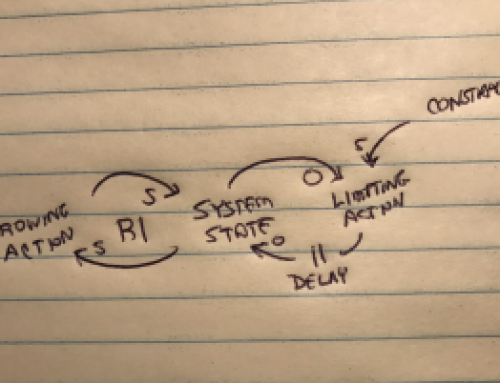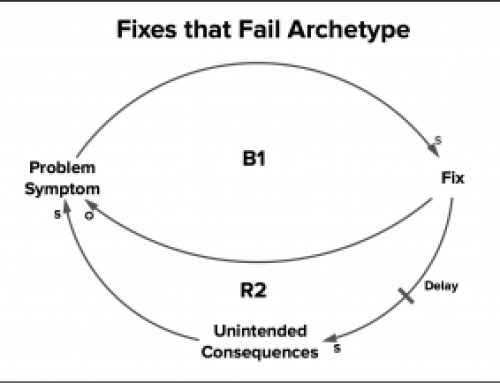It is very likely that most of you approach business challenges and decisions using only two sets of eyes, or said another way, from two points of views. You certainly assess them from your own point of view (your eyes) and all that comes with that. You are a primary stakeholder in any decision. Your decisions affect you directly, and you influence any decision with your own thinking. I am also asserting that you likely engage others in your business for their input when making decisions. This is the second “set of eyes” or the second point of view you regularly engage when making decisions. However, it is important to recognize that if you are engaging those on your own team, your manager, or perhaps others in company management, you are also engaging stakeholders in the actual outcome of decisions and therefore, those giving you input are also bringing with them a point of view that is influenced by any decision.
Of course, there is absolutely nothing wrong with this very normal circle of influence around decisions and any business leader would certainly engage their own intuition, knowledge, experience and wisdom in making decisions and also engage others in the organization that work closely with their own group. However, I am suggesting that you can and will find tremendous value from looking for and engaging with a third set of eyes, a coach or advisor point of view that is removed from the direct impact and consequences of your business decisions.
So who offers a good third set of eyes, and what kinds of interactions should you be having?
A Good Third Set of Eyes
What kind of person is going to offer the right third set of eyes? Who should you be looking for and considering? Here are the characteristics I suggest you put on your short-list of qualifications.
Someone who also chooses you – This kind of relationship works best if you can find someone who also uses you in the same capacity. You develop a strong relationship of mutual trust and respect as you listen and share with one another.
Someone that asks thoughtful questions – This coach/advisor needs to ask great questions that force you to go deeper, consider alternatives, challenge your own pre-dispositions and biases, see new possibilities, etc.
Someone that listens well and does not offer advice – This person should listen a lot, listening to what you say and also what is not said, and not readily offer advice. Sometimes you will want to voice various “what-if” types of scenarios freely and just have your coach probe, ask questions, and follow your train of thought as you work things out. The whole point of this relationship is for your coach-advisor to allow you to explore, ask you the good questions, make a few observations, and primarily allow you to self-discover your own path.
Someone that definitely has something to offer – Your third set of eyes should have either a unique perspective, specific experience relating to discussions, the ability to customize content based on the situation, forces you outside of your comfort zone and normal “box”, or all of the above.
Someone that you are comfortable with – Your coach/advisor should be a person that you are personally and intellectually compatible with and has some understanding of your strengths and weaknesses (and vice versa).
Someone that has no conflict of interest – This person should have no conflict of interest in any way – personally or from a business point of view. It is important that this person is NOT a stakeholder in decisions that you are discussing.
Ultimately, when looking for a person that fits the above criteria, the final litmus will be things like “do I trust this person’s ethics, integrity, honesty?” “do I trust their competence in related knowledge and understanding of my business or similar business circumstances?,” and “does this person have any specific interest at all that might hamper his or her ability to be straight with me?”
Framing the Use of that Third Set of Eyes
Once you enter into this “third set of eyes” or coach/advisor relationship, what then? What kind of discussions will you have? Is this like therapy and you just talk about whatever is happening in the moment? Well, it all depends.
I want to suggest that for each discussion, it will be helpful to recognize the “type” of conversation you are expecting to engage in so that you can gain the maximum benefit from the interaction. First, how should you best organize your meetings (at least those that you plan formally)?
Determine the best meeting format – Given everyone’s busy schedule, it will probably help to determine ahead of time the best meeting structure that works best for both parties. For example, you could arrange two meetings per month and simply give priority to one person for each meeting in terms of the agenda, basically alternating control of who is acting as coach and who is directing the agenda topics. The other common practice would be to simply divide your meeting time in half, giving each person focused agenda time at each meeting. The key for this approach is that you will likely need to schedule a larger block of time for each meeting.
The point is that if you leave these meetings unplanned and rely on just the serendipity of the flow in conversation, you will likely find yourselves bouncing around too much from topic to topic and rendering your time ineffective for one or both parties involved.
Recognize the type of discussion content format guiding your discussion – Not all discussions are alike in terms of purpose or desired outcome. You and your advisor should start each discussion with a clear understanding of the overall purpose and general desired outcome for that discussion. Also, just as a matter of courtesy, you should probably not waste a great deal of time just “venting.” You can vent to your significant other who will just say “uh-uh” and “yes honey” and let you get the steam out. The relationship with your coach/advisor should focus more on productive content. With that said, here are the three basic types of conversation frameworks that are helpful to identify and understand as you enter a discussion:
1. The Sounding Board
This type of coaching conversation are more tactical and includes topics such as discussing specific new ideas or a specific new strategy you are considering, or specific actions/decisions are you considering in the near future, or perhaps organizational structure. When an advisor clearly understands that this is the type of conversation you are having, the advisor can focus on key questions and probing around the “why” and “what” areas of your thinking and also allow you to fully explore the what-if scenarios in terms of various actions and consequences. An advisor is especially helpful when discussing specific decisions that you absolutely cannot discuss with your “second set of eyes” group given that the topic might be inappropriate (may concern layoffs or employee performance) or cause concern prematurely (create worry or cause specific actions prematurely).
2. The Big Picture Thinking/Review
This type of discussion would tend to stay more strategic and include topics such as what future state you see that is possible, validity of that future, how you see the journey to get there in terms of strategy and objectives, or perhaps discussing how the current strategy is working and where you might look for improvements or identify roadblocks. You and your advisor are focused more on the future and the “what-ifs” and “how could we” and “is this future something that is attainable and real.” This is where great value can be found with an advisor that can ask relevant and probing questions and also has similar experiences to share.
3. The Professional Growth Experience
This type of discussion would focus more on your own growth as a professional and includes topics such as how you can continue to grow as a leader, how you can continue learning, how you can expand your ability to think creatively, etc. This type of conversation may include a great deal more interaction and back and forth spontaneous help for each person (shifting roles back and forth a bit) as you share how you best learn, what you read, how you challenge yourself to grow, and as you challenge each other to think in new ways.
Armed with the understanding of these three very different types of conversations you may enter into with your advisor will hopefully aid you in planning your agenda and setting expectations for the outcome of specific discussions.
Find your Third Set of Eyes
I don’t doubt that each of you likely have someone that today is your “go to” person when you need to discuss challenging or difficult decisions. However, I would also assume that for many of you that is either a friend (or significant other) who may or may not fully appreciate or understand your situation or it may be someone you trust at work, but in reality they do have a significant stake in the outcome of your decisions and therefore cannot fully separate their own desires from the discussion. Either way, you are shortchanging yourself in a couple of ways. First, you are not receiving the benefit of having a coach/advisor that has the full qualifications to assist you and is truly free of the personal and structural conflicts of interests. Second, you are likely failing to get assistance with professional growth from a peer that has experience and wisdom to offer you. I strongly recommend that you begin searching today for that “third set of eyes” that you can engage in a reciprocal and meaningful, and hopefully long-term coaching partnership.

